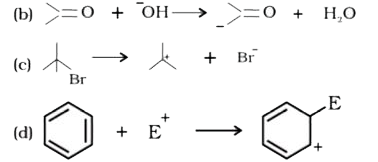Complete Solutions to EXERCISES of chapter ORGANIC CHEMISTRY - SOME BASIC PRINCIPLES AND TECHNIQUES of Class 11 book with complete answers and questions
| Class 11 | CHEMISTRY |
| Chapter | ORGANIC CHEMISTRY - SOME BASIC PRINCIPLES AND TECHNIQUES |
| NCERT TELUGU | EXERCISES |
| Number Of Questions | 39 |
| Academic Year | 2023-24 |
What are hybridisation states of each carbon atom in the following compounds ?
`CH_(2)=C=O,CH_(3)CH=CH_(2),(CH_(3))_(2)CO,CH_(2)=CHCN,C_(6)H_(6)`
View SolutionIndicate the σ and π bonds in the following molecules :
`C_(6)H_(6),C_(6)H_(12),CH_(2)Cl_(2),CH_(2)=C=CH_(2),CH_(3)NO_(2),HCONHCH_(3)`
View SolutionWrite bond line formulas for : Isopropyl alcohol, 2,3-Dimethyl butanal, Heptan-4- one.
View SolutionGive the IUPAC names of the following compounds :
(a) (b) `Cl_(2)CHCH_(2)OH`
(b) `Cl_(2)CHCH_(2)OH`
View SolutionWhich of the following represents the correct IUPAC name for the compounds concerned ? (a) 2,2-Dimethylpentane or 2-Dimethylpentane (b) 2,4,7- Trimethyloctane or 2,5,7-Trimethyloctane (c) 2-Chloro-4-methylpentane or 4-Chloro-2-methylpentane (d) But-3-yn-1-ol or But-4-ol-1-yne.
View SolutionDraw formulas for the first five members of each homologous series beginning with the following compounds. (a) `H-COOH` (b) `CH_(3)COCH_(3)` (c ) `H-CH=CH_(2)`
View SolutionGive condensed and bond line structural formulas and identify the functional group(s) present, if any, for :
(a) 2,2,4-Trimethylpentane
(b) 2-Hydroxy-1,2,3-propanetricarboxylic acid
(c) Hexanedial
View SolutionIdentify the functional groups in the following compounds

View SolutionWhich of the two: `O_(2)NCH_(2)CH_(2)O^(–)` or `CH_(3)CH_(2)O^(–)` is expected to be more stable and why ?
View SolutionExplain why alkyl groups act as electron donors when attached to a `π` system.
View SolutionDraw the resonance structures for the following compounds. Show the electron shift using curved-arrow notation.
(a) `C_(6)H_(5)OH` (b) `C_(6)H_(5)NO_(2)` (c ) `CH_(3)CH=CHCHO` (d) `C_(6)H_(5)-CHO` (e) `C_(6)H_(5)-overset(+)(C )H_(2)` (f) `CH_(3)CH=CHoverset(+)(C )H_(2)`
View SolutionWhat are electrophiles and nucleophiles ? Explain with examples.
View SolutionIdentify the reagents shown in bold in the following equations as nucleophiles or electrophiles:
(a) `CH_(3)COOH+HO^(-)rarrCH_(3)COO^(-)+H_(2)O`
(b) `CH_(3)COCH_(3)+overset(-)(C )Nrarr(CH_(3))_(2)C(CN)(OH)`
(c ) `C_(6)H_(5)+CH_(3)overset(+)(C )OrarrC_(6)H_(5)COCH_(3)`
View SolutionClassify the following reactions in one of the reaction type studied in this unit.
(a) `CH_(3)CH_(2)Br+HS^(-)rarrCH_(3)CH_(2)SH`
(b) `(CH_(3))_(2)C=CH_(2)+Hclrarr(CH_(3))_(2)ClC`
(c ) `CH_(3)CH_(2)Br+HO^(-)rarrCH_(2)=CH_(2)+H_(2)C`
(d) `(CH_(3))_(3)C-CH_(2)OH+HBr rarr(CH_(3))_(2)CBrCH_(2)CF`
View SolutionFor the following bond cleavages, use curved-arrows to show the electron flow and classify each as homolysis or heterolysis. Identify reactive intermediate produced as free radical, carbocation and carbanion.
(a) `CH_(3)O-OCH_(3)rarrCH_(3)overset(.)O+overset(.)(O)CH_(3)`
(b)
View SolutionExplain the terms Inductive and Electromeric effects. Which electron displacement effect explains the following correct orders of acidity of the carboxylic acids?
(a) `Cl_(3)C COOHgtCl_(2)CHCOOHgtClCH_(2)COOH`
(b) `CH_(3)CH_(2)COOHgt(CH_(3))_(2)CHCOOHgt(CH_(3))_(2)C.COOH`
View SolutionGive a brief description of the principles of the following techniques taking an example in each case.
(a) Crystallisation (b) Distillation (c) Chromatography
View SolutionDescribe the method, which can be used to separate two compounds with different solubilities in a solvent S.
View SolutionWhat is the difference between distillation, distillation under reduced pressure and steam distillation ?
View SolutionDiscuss Lassigne's test.
View SolutionDifferentiate between the principal of estimation of nitrogen in an organic compound by (i) Kjeldehl's method and (ii) Dumas method.
View SolutionExplain the estimation of phosphorus and sulphur present in the organic compound
View SolutionExplain the principle of chromatography.
View SolutionWhy is nitric acid added to sodium extract before adding silver nitrate for testing halogens?
View SolutionExplain the reason for the fusion of an organic compound with metallic sodium for testing nitrogen, sulphur and halogens.
View SolutionName a suitable technique of separation of the components from a mixture of calcium sulphate and camphor.
View SolutionExplain why an organic liquld vaporizes at a temperature below its bolling point in Its steam distillation.
View SolutionWill `C Cl_(4)` give white precipitate of AgCl on heating it with silver nitrate? Give reason for your answer.
View SolutionWhy is a solution of potassium hydroxide used to absorb carbon dioxide evolved during the estimation of carbon present in an organic compound?
View SolutionWhy is it necessary to use acid and not sulphuric acid for acidification of sodium extract for testing sulphur by lead acetate test?
View SolutionAn organic compound contains 69% carbon and 4.8% hydrogen, the remainder being oxygen. Calculate the masses of carbon dioxide and water produced when 0.20 g of this substance is subjected to complete combustion.
View SolutionA sample of 0.50 g of an organic compound was treated according to Kjeldahl’s method. The ammonia evolved was absorbed in 50 ml of `0.5 M H_(2)SO_(4)`. The residual acid required 60 mL of 0.5 M solution of NaOH for neutralisation. Find the percentage composition of nitrogen in the compound.
View Solution0.3780 g of an organic chloro compound gave 0.5740 g of silver chloride in Carius estimation. Calculate the percentage of chlorine present in the compound.
View SolutionIn the estimation of sulphur by Carius method, 0.468 g of an organic sulphur compound afforded 0.668 g of barium sulphate. Find out the percentage of sulphur in the given compound.
View SolutionIn the organic compound `CH_(2)=CH-CH_(2)-CH_(2)-C-=CH`, the pair of hydridised orbitals involved in the formation of: `C_(2) – C_(3)` bond is:
(a) `sp-sp^(2)` (b) `sp-sp^(3)` (c ) `sp^(2)-sp^(3)` (d) `sp^(3)-sp^(3)`
View SolutionIn the Lassaigne’s test for nitrogen in an organic compound, the Prussian blue colour is obtained due to the formation of:
(a) `Na_(4)[Fe(CN)_(6)]` (b) `Fe_(4)(CN_(6)]_(3)` (c ) `Fe_(2)[Fe(CN)_(6)]` (d) `Fe_(3)[Fe(CN)_(6)]_(4)`
View SolutionWhich of the following carbocation is most stable ?
(a) `(CH_(3))_(3)C.overset(+)(C )H_(2)` (b) `(CH_(3))_(3)overset(+)(C )` (c ) `CH_(3)CH_(2)overset(+)(C )H_(2)` (d) `CH_(3)overset(+)(C )HCH_(2)CH_(3)`
View SolutionThe best and latest technique for isolation, purification and separation of organic compounds is:
(a) Crystallisation (b) Distillation (c) Sublimation (d) Chromatography
View SolutionThe reaction:
`CH_(3)CH_(2)I+KOH(aq)rarrCH_(3)CH_(2)OH+KI`
is classified as :
(a) electrophilic substitution (b) nucleophilic substitution (c) elimination (d) addition
View Solution
EXERCISES questions and complete solutions for chapter ORGANIC CHEMISTRY - SOME BASIC PRINCIPLES AND TECHNIQUES of NCERT CHEMISTRY(TELUGU) of Class 11